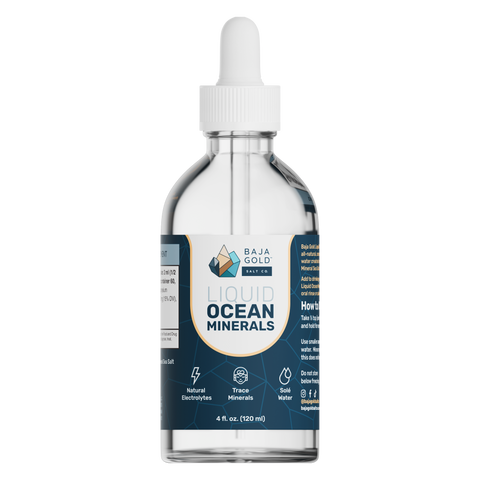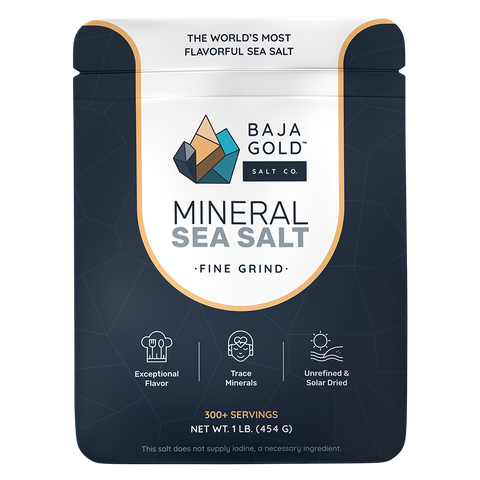Sea Salt: What’s Fact and What’s Fiction?

Sea Salt: What’s Fact and What’s Fiction?
At a Glance: Sea salt is created by evaporating seawater, leaving behind sodium chloride and naturally occurring trace minerals. Unlike table salt, which is refined to near-pure sodium chloride, sea salt (particularly unrefined sea salt) retains its mineral content and has a more complex, bold flavor.
Salt has a long, complicated reputation. On one hand, it’s one of the oldest and most valuable substances in human history, used for food preservation, trade, and even as currency. On the other hand, modern nutrition headlines often focus on salt as a health hazard, linking sodium to high blood pressure and cardiovascular disease.
The truth is more nuanced. Not all salts are the same, and how salt is sourced, processed, and used makes a big difference for both flavor and health.
Where Does Sea Salt Come From?
One way sea salt can be harvested is directly from seawater through evaporation. In climates with low humidity, rainfall, and steady winds, seawater is collected in shallow ponds where the sun and wind slowly evaporate the water, leaving behind crystals of salt and minerals. This process can take weeks to months, depending on environmental conditions.
In some regions, salt is harvested mechanically, but in many traditional saltworks, workers still rake and gather salt by hand. This minimal processing preserves its natural mineral content, which includes magnesium, calcium, potassium, and dozens of other trace minerals.
These are just two of many different ways sea salt is extracted.
How does sea salt differ from table salt?
Table salt is mined from underground salt deposits that formed millions of years ago when ancient seas dried up. This raw salt is then refined, bleached, and stripped of most minerals until almost nothing remains but sodium chloride. Anti-caking agents are added to make it flow smoothly. Iodine is also added in many countries to prevent iodine deficiency

Fun fact:
Historically, sea salt was considered a luxury product in inland areas, while coastal communities used it daily. Today, with better distribution, high-quality mineral sea salt is more widely available.
Is Sea Salt Good for You?
This question gets asked often, and the answer depends on what we mean by “good.” Sea salt is still mostly sodium chloride, but because it retains natural trace minerals, it offers advantages over highly refined table salt.
What Is the Nutritional Value of Sea Salt?
Key nutrients within Sea Salt are:
-
Sodium: aiding fluid balance, transmitting nerve signals, and supporting muscle contractions.
-
Magnesium: helps with muscle relaxation, hydration, and energy production
-
Calcium: supports bone health and nerve signaling
-
Potassium: balances fluids and supports cardiovascular function
-
Dozens of trace minerals (like zinc, iron, and manganese) that help contribute to cellular health.
Location and harvest method play into the profiles of sea salt. Baja Gold has been analyzed within 3rd-party laboratories to contain the greatest abundance of macro and trace minerals.
Benefits of Sea Salt, At a Glance
-
Contains natural mineral content not found in refined table salt.
-
Delivers bold, natural flavor with less sodium needed.
-
Free from additives like anti-caking agents.
Flavor and Usage
Sea salt crystals are typically larger and more irregular than table salt. This means:
-
They pack less sodium per teaspoon because they’re less dense.
-
They dissolve more slowly, creating even flavoring on the tongue.
-
Many people find they can season food with less salt overall, because the flavor is stronger and more satisfying.
A Balanced View
While sea salt is often described as “healthier” than table salt, it’s not a free pass to consume unlimited amounts. It’s still sodium chloride, and excess sodium intake can strain the body. The advantage of sea salt is in its mineral content and flavor profile, which lets you get more out of each pinch.
Does Sea Salt Contain Iodine?
The short answer: yes, usually only in small, natural amounts. For more detailed information about the iodine content in mineral salt, refer to the nutrition facts on our website.
Why Does Iodine Matter and Where Does it Come From?
In the early 20th century, iodine deficiency was widespread in certain regions. To fix this, governments encouraged fortifying table salt with iodine, which nearly eliminated iodine deficiency in developed countries.
Iodine is necessary for the production of thyroid hormones. These hormones regulate metabolism, body temperature, and energy levels. Without enough iodine, people can develop goiter (thyroid swelling), fatigue, or metabolic issues. As always, consult your healthcare provider if you experience these symptoms, as there could be other medical factors at play.
How Does Sea Salt Compare to Iodized Salt?
-
Sea salt contains naturally occurring iodine, but the levels are variable and much lower than fortified table salt.
-
Relying only on sea salt for iodine is usually not enough.
-
Other iodine-rich foods include seaweed, shellfish, cod, dairy, and eggs.
Practical Takeaway
If you love sea salt for its taste and mineral content, keep using it, but remember to include iodine-rich foods in your diet for thyroid health. Many health advocates recommend sea salt plus iodine-rich foods as the best of both worlds.
Does Sea Salt Raise Blood Pressure?
The concept of salt and blood pressure is one of the most debated topics in nutrition. Here are some things to know:
-
Sodium, found in all salts, can raise blood pressure if consumed in excess or if the consumer has existing conditions that may lead them to be salt-sensitive.
-
Sea salt and table salt both contain sodium chloride.
-
Especially when using natural grain or coarse sea salt, you might find yourself using less by volume, which can reduce overall sodium intake, also keeping in mind the lower sodium content found in sea salt.
Breaking It Down
-
Table Salt: Fine, dense, and ultra-processed → packs more sodium per teaspoon.
-
Sea Salt: Available in various textures and unrefined → less sodium per teaspoon.
Total daily sodium intake from processed foods, restaurant meals, and packaged snacks is usually the biggest contributor to high sodium intake.
What to Know
-
Moderation matters more than salt type.
-
Sea salt can help because its flavor allows for less sodium with more taste.
-
Choosing a high-mineral salt adds trace nutrients rather than just sodium.
Baja Gold Sea Salt: Balance Between Flavor and Health
Baja Gold is harvested from seawater in the Sea of Cortez, an area rich in minerals thanks to its unique geology and climate. Unlike processed table salt, it’s left unrefined, which means it retains a wide spectrum of natural minerals.
-
Lower sodium: Up to 20-25% less sodium than standard table salt.
-
High mineral content: Including magnesium, potassium, and calcium.
-
Natural flavor: Bold taste that satisfies with fewer sprinkles.
How People Use Baja Gold
-
Biohackers & athletes: Mix a pinch into water for hydration and electrolyte balance.
-
Families: Use it in cooking and baking as a natural, flavorful alternative to refined salt.
-
Wellness enthusiasts: Sprinkle it on whole foods like vegetables, eggs, or meat for added minerals.
Most people think of salt as just “sodium.” Baja Gold reframes salt as a source of natural trace minerals for health and performance. Instead of stripping away everything but sodium chloride, Baja Gold preserves more of what nature created.
Unlock The Benefits of Mineral Sea Salt
So, what is sea salt? It’s salt from evaporated seawater. It’s mineral-rich, flavorful, and less processed than traditional table salt.
-
It comes from the sea, not underground deposits.
-
It’s richer in minerals than refined table salt.
For those who want the best of both worlds (flavor and health), Baja Gold Sea Salt stands out. With its high mineral content, lower sodium, and bold natural taste, it’s more than just a seasoning. It’s a mineral salt that fits into modern wellness lifestyles, ancestral nutrition patterns, and everyday family cooking.



